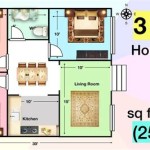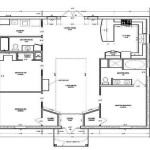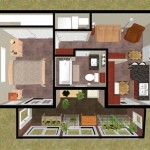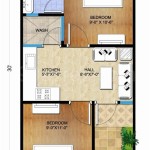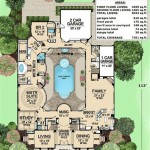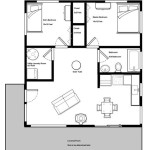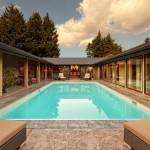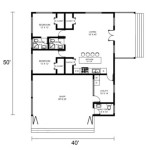American Foursquare House Plans: A Study in Efficiency and Style
The American Foursquare, also known as the Prairie Box, is a distinctly American architectural style that enjoyed widespread popularity from the late 1890s to the 1930s. Characterized by its simple, box-like shape, efficient use of space, and adaptability to various decorative styles, the Foursquare represents a practical and appealing housing solution that continues to resonate with homeowners today. This article will explore the key features of American Foursquare house plans, examine the reasons for their historical popularity, and discuss their enduring appeal in contemporary architecture.
The Foursquare emerged as a counterpoint to the more ornate and elaborate styles of the Victorian era. As urban populations grew and land became more valuable, there was a growing need for housing that maximized space usage while remaining affordable and aesthetically pleasing. The Foursquare directly addressed these needs, offering a design that was both functional and easily customizable. Its simple geometry and adaptable interior layout made it a suitable choice for a wide range of families and budgets.
The style's widespread adoption was also facilitated by the rise of pattern books and mail-order architectural plans. Companies like Sears, Roebuck and Co. offered complete house kits, including precut lumber and detailed instructions, allowing individuals to build their own homes with relative ease. These kits made homeownership more accessible and contributed to the widespread dissemination of the Foursquare design across the United States, particularly in the Midwest and other rapidly developing regions.
Key Features of American Foursquare House Plans
Several defining characteristics distinguish the American Foursquare from other architectural styles. These features contribute to its efficiency, functionality, and enduring appeal.
First and foremost is the house's box-like shape. The Foursquare is typically a two-and-a-half-story structure with a square or nearly square footprint. This compact form maximizes interior space and minimizes exterior wall area, contributing to energy efficiency. The simple geometry also makes construction relatively straightforward and cost-effective.
Another hallmark of the Foursquare is its hipped roof, which slopes gently on all four sides. The hipped roof provides good drainage and resists wind damage, making it a practical choice for a variety of climates. Often, a dormer window is incorporated into the attic space, providing natural light and ventilation to what would otherwise be an unusable area. This dormer can take various forms, including a gable dormer or a shed dormer, depending on the desired aesthetic and functional requirements.
A prominent front porch is another common feature of American Foursquare houses. The porch provides a welcoming space for residents and visitors and serves as a transition zone between the interior and exterior. Porches are often supported by substantial columns, ranging from simple square posts to more elaborate tapered columns, depending on the overall style of the house.
The interior layout of a Foursquare is typically organized around a central staircase, which provides access to the upper floors. The main level usually includes a living room, dining room, kitchen, and often a small entry foyer or mudroom. The upper floor typically contains bedrooms and a bathroom. The attic space can be used for storage or finished as additional living space. The basement, often unfinished, provides space for utilities and storage.
These fundamental elements of Foursquare house plans contributed significantly to the style's practicality and attractiveness. The straightforward design, combined with the flexibility for personalization, made it a popular choice for families seeking affordable and functional housing.
Reasons for Historical Popularity
Several factors contributed to the widespread popularity of the American Foursquare during its heyday. These factors relate to the social, economic, and technological changes that were occurring in the United States at the turn of the 20th century.
The Foursquare's emphasis on efficiency and functionality resonated with the growing middle class. As more Americans moved to cities and suburbs, they sought housing that was both practical and affordable. The Foursquare provided a solution that met these needs, offering ample living space in a compact and easily manageable form.
The rise of the Arts and Crafts movement also influenced the popularity of the Foursquare. The Arts and Crafts movement promoted simple, honest design and craftsmanship, rejecting the excessive ornamentation of the Victorian era. While Foursquare houses could be decorated in various styles, they often incorporated Arts and Crafts elements, such as built-in cabinetry, natural materials, and simple, clean lines. This aesthetic appealed to those who valued simplicity and authenticity.
The availability of mail-order house plans from companies like Sears, Roebuck and Co. played a crucial role in the widespread dissemination of the Foursquare design. These plans made it possible for individuals to build their own homes, even if they lacked formal architectural training. The affordability and accessibility of these plans democratized homeownership and contributed to the rapid growth of suburban communities.
Furthermore, the Foursquare's adaptability allowed it to be customized to suit individual tastes and budgets. While the basic form remained consistent, the exterior detailing and interior finishes could be varied to reflect the owner's preferences. This flexibility made the Foursquare a versatile choice that could be adapted to different architectural styles, including Prairie School, Colonial Revival, and Craftsman. This adaptability helped ensure its continued popularity over several decades.
Enduring Appeal and Contemporary Relevance
Despite its age, the American Foursquare continues to hold appeal for homeowners today. Its timeless design, efficient use of space, and adaptability to modern lifestyles contribute to its enduring popularity. Modern interpretations of the Foursquare often incorporate updated materials, energy-efficient technologies, and contemporary interior layouts, while retaining the fundamental characteristics that made the style so popular in the past.
The Foursquare's efficient use of space remains a significant advantage in today's housing market. As land values continue to rise, maximizing interior space becomes increasingly important. The Foursquare's compact form and efficient layout offer a practical solution for those seeking comfortable living spaces in urban and suburban areas.
The style's adaptability also makes it a suitable choice for those who want to personalize their homes. The simple, clean lines of the Foursquare provide a blank canvas for a variety of decorative styles, allowing homeowners to create spaces that reflect their individual tastes and preferences. Whether furnished with vintage antiques or modern minimalist pieces, the Foursquare can accommodate a wide range of design aesthetics.
Furthermore, the Foursquare's commitment to craftsmanship and quality construction aligns with contemporary values. Many homeowners are seeking homes that are built to last, using sustainable materials and energy-efficient technologies. The Foursquare, with its solid construction and timeless design, provides a foundation for creating a durable and environmentally responsible home.
Contemporary architects and builders often draw inspiration from the Foursquare when designing new homes. By incorporating the style's key features, such as its box-like shape, hipped roof, and prominent porch, they can create homes that are both functional and aesthetically pleasing. These modern interpretations often incorporate open floor plans, updated kitchen and bathroom designs, and energy-efficient windows and insulation, while retaining the charm and character of the original Foursquare design.
In conclusion, the American Foursquare represents a significant contribution to American residential architecture. Its efficient design, adaptability, and enduring appeal have made it a popular choice for homeowners for over a century. By examining the key features, historical context, and contemporary relevance of the Foursquare, we can gain a deeper appreciation for this remarkable architectural style and its lasting influence on the built environment.

An American Foursquare Story Four Square Homes House Plans Vintage

Chicago Vernacular Architecture

Modern American Homes Classic Foursquare C L Bowes 1918 Square House Plans Four

Traditional Four Square House Plan 50100ph Architectural Designs Plans

10 More Sears Foursquare Kit House Plans Part 2 Everyday Old

The Foursquare Past Present Everett Custom Homes

1925 Lewis Built Catalog Homes The Portland Square House Plans Four

Change Happens American Foursquare

Our House Plans Right Home Company

Frame Masonry Foursquare University Of Cky College Arts Sciences

